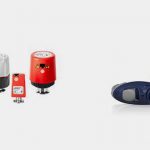Is there really such a thing as ‘good vibrations’ when you’re in an industrial setting? Perhaps somewhere, but by and large, what you want is some way to keep the vibrations at bay, away from the fragile bits and pieces. The traditional solution for this problem is ‘solid state’ — in that it’s a metal spring, or some other form of flexible-but-solid material such as hard rubber that has give, but isn’t fluid.
The Firestone Airmount isolator is a beast of a different stripe, because the load-bearing element is quite literally air. The unique four-layer-but-two-ply construction of the vulcanized rubber ‘bubble’ keeps the air in place, but doesn’t itself hold any weight whatsoever. This gives the Airmount some incredible advantages no other isolator has, like:
- Incredibly Low System Frequencies: Most isolators have system frequencies around 8 hertz; the Airmount can go as low as 60 cycles per minute — that’s 1 hertz — and it can drop even lower with the addition of an optional auxiliary reservoir.
- Constant System Frequencies: Whereas most ‘solid’ solutions have a system frequency that changes as the load gets greater (and thus requires the load to be evenly balanced across all isolators), the Airmount’s natural system frequency is independent of weight — so your load can be imbalanced without affecting the Airmount’s ability to reduce vibration.
- Wide Weight Range: Airmount isolators can handle as little as 100 up to as many as 100,000 pounds per mounting point.
- Compact, Controllable Height: The Airmount isolator stands a mere 2.5 inches high (at minimum), giving much better isolation than a metal spring at 1/2 to 1/4 the height — but because the height is controlled by its internal air pressure, if you need your Airmount to run a little taller, that’s not a problem, either.
- Noise Reduction: Unlike solid solutions, the Airmount transfers almost no noise from one side to the other, and generate even less noise on their own.
Because the Airmount is so compact and so effective at isolating vibration, it’s often used twice: once between a piece of heavily-vibrating machinery and the structural elements around it, and then again between the structural elements and any particularly sensitive equipment on the same system. Used thusly, they promote both structural stability and can dramatically extend the life of sensitive equipment compared to conventional solutions.























